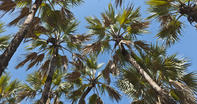
Name
Lala Palm Tree (Hyphaene coriacea)Description
The lala palm tree grows about 5 to 7 m in height, but can reach 15 m. Its stems, growing singly or as more than one, thicken slightly halfway up. Its leaves are greyish-green in colour and resemble the form of a fan.
The fruits are the size of tennis balls, changing in colour as they ripen from green to orange, to a shiny dark brown. Each tree can produce as many as 2000 fruits, taking two years to mature and two more years to fall. The seeds of these fruits are covered in a thin layer of sweet, ginger-flavoured, soft, fibrous pulp. This tree is locally known as the Molalla tree.
Lala Palm Tree Fruit
The fruit of the lala palm varies according to its location. Usually the fruit are green in colour, then turning light orange and browning with age. Its shell is shiny and hard, and inside its seeds are covered in a soft, fibrous pulp.
These fruits are an irregular pear shape, measuring 60 to 80 mm in diameter. It has a strong, sweet and fruity scent. The hard endosperm is hollow and not unlike vegetable ivory. These fruits are distributed by elephants, baboons and monkeys.
Lala Palm Tree Uses
The young fruit has a milk similar to coconut milk in flavour and colour. Elephants enjoy eating the new leaves, having a coconut flavour and being crispy at the stem. The crown-heart of the lala palm tree fruit is eaten as a vegetable, the pulp being ginger-like and rather tasty.
To get the pulp from the fruit’s tough exocarp it is beaten with a stick. The lala palm is exploited as a wine source, and thereby many are killed. Palm swifts are closely associated with the lala palm tree and can be seen nesting vertically under its leaves.
To prevent their eggs from falling from the nest, these birds have evolved a unique method by glueing their eggs in place with their saliva. Resembling the commercial vegetable ivory of South America, the kernels are often used to make curios, ornaments and trinkets, however, the hard kernels of the seeds are of little commercial or economic value as they are too small.